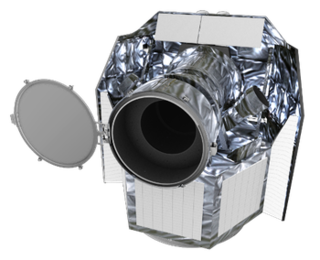Related Research Articles
WASP-33b is an extrasolar planet orbiting the star HD 15082. It was the first planet discovered to orbit a Delta Scuti variable star. With a semimajor axis of 0.026 AU and a mass likely greater than Jupiter's, it belongs to the hot Jupiter class of planets.

CHEOPS is a European space telescope. Its objective is to determine the size of known extrasolar planets, which will allow the estimation of their mass, density, composition and their formation. Launched on 18 December 2019, it is the first Small-class mission in ESA's Cosmic Vision science programme.

WASP-121b, formally named Tylos, is an exoplanet orbiting the star WASP-121. WASP-121b is the first exoplanet found to contain water in an extrasolar planetary stratosphere. WASP-121b is in the constellation Puppis, and is about 858 light-years from Earth.
WASP-49 is a yellow dwarf main-sequence star. Its surface temperature is 5600 K. WASP-49 is depleted of heavy elements relative to Sun, with metallicity Fe/H index of -0.23, meaning it has an abundance of iron 59% of the Sun's level.
WASP-50 is a G-type main-sequence star about 610 light-years away. The star is older than the Sun and slightly depleted in heavy elements compared to the Sun, and has a close to average starspot activity. Despite its advanced age, the star is rotating rapidly, being spun up by the tides raised by giant planet on close orbit.
WASP-72 is the primary of a binary star system. It is an F7 class dwarf star, with an internal structure just on the verge of the Kraft break. It is orbited by a planet WASP-72b. The age of WASP-72 is younger than the Sun at 3.55±0.82 billion years.
WASP-62, formally named Naledi, is a single star about 573 light-years away. It is an F class main-sequence star, orbited by a planet, WASP-62b. The age of WASP-62 is much younger than the Sun at 0.8±0.6 billion years, and it has a metal abundance similar to the Sun.
WASP-54, also known as BD+00 3088, is a binary star system about 825 light-years away. The primary, WASP-54A, is a F-type main-sequence star, accompanied by the red dwarf WASP-54B on a wide orbit. WASP-54 is depleted in heavy elements, having 55% of the solar abundance of iron. The age of WASP-54 is slightly older than the Sun's at 6.9+1.0
−1.9 billion years.
WASP-52 is a K-type main-sequence star about 570 light-years away. It is older than the Sun at 10.7+1.9
−4.5 billion years, but it has a similar fraction of heavy elements. The star has prominent starspot activity, with 3% to 14% of the stellar surface covered by areas 575±150 K cooler than the rest of the photosphere.
WASP-69, also named Wouri, is a K-type main-sequence star 164 light-years away. Its surface temperature is 4782±15 K. WASP-69 is slightly enriched in heavy elements compared to the Sun, with a metallicity Fe/H index of 0.10±0.01, and is much younger than the Sun at 2 billion years. The data regarding starspot activity of WASP-69 are inconclusive, but spot coverage of the photosphere may be very high.
WASP-75 is a F-type main-sequence star about 980 light-years away. The star is much younger than the Sun at approximately 2.9±0.2 billion years. WASP-75 is similar to the Sun in its concentration of heavy elements.
WASP-88 is a F-type main-sequence star. Its surface temperature is 6450±61 K. WASP-88 is similar to the Sun in its concentration of heavy elements, with a metallicity Fe/H index of 0.03±0.04, and is younger at an age of 3.0±1.3 billion years.
WASP-80 is a K-type main-sequence star about 162 light-years away. The star's age is much younger than the Sun's at 1.352±0.222 billion years. WASP-80 is similar to the Sun in concentration of heavy elements, although this measurement is highly uncertain.

WASP-96b is a gas giant exoplanet. Its mass is 0.48 times that of Jupiter. It is 0.0453 AU from the class G star WASP-96, which it orbits every 3.4 days. It is about 1,140 light-years away from Earth, in the constellation Phoenix. It was discovered in 2013 by the Wide Angle Search for Planets (WASP).
References
- 1 2 3 University of Bern (28 September 2020). "First study with CHEOPS data describes one of the most extreme planets in the universe". EurekAlert! . Retrieved 28 September 2020.
- 1 2 3 "First results from Cheops: ESA's exoplanet observer reveals extreme alien world". esa.int. Esa. Retrieved 28 September 2020.
- ↑ Deline, A.; et al. (2022), "The atmosphere and architecture of WASP-189 b probed by its CHEOPS phase curve", Astronomy & Astrophysics, 659: A74, arXiv: 2201.04518 , Bibcode:2022A&A...659A..74D, doi:10.1051/0004-6361/202142400, S2CID 245877604
- 1 2 Lendl, M.; et al. (17 September 2020). "The hot dayside and asymmetric transit of WASP-189 b seen by CHEOPS?" (PDF). Astronomy & Astrophysics . 643: A94. arXiv: 2009.13403 . Bibcode:2020A&A...643A..94L. doi: 10.1051/0004-6361/202038677 . Retrieved 28 September 2020.
- ↑ Anderson, D. R.; Temple, L. Y.; Nielsen, L. D.; Burdanov, A.; Hellier, C.; Bouchy, F.; Brown, D. J. A.; Collier Cameron, A.; Gillon, M.; Jehin, E.; Maxted, P. F. L.; Pepe, F.; Pollacco, D.; Pozuelos, F. J.; Queloz, D.; Ségransan, D.; Smalley, B.; Triaud, A. H. M. J.; Turner, O. D.; Udry, S.; West, R. G. (2018). "WASP-189b: An ultra-hot Jupiter transiting the bright a star HR 5599 in a polar orbit". arXiv: 1809.04897 [astro-ph.EP].
- ↑ Prinoth, B.; Hoeijmakers, H. J.; Kitzmann, D.; Sandvik, E.; Seidel, J. V.; Lendl, M.; Borsato, N. W.; Thorsbro, B.; Anderson, D. R.; Barrado, D.; Kravchenko, K.; Allart, R.; Bourrier, V.; Cegla, H. M.; Ehrenreich, D.; Fisher, C.; Lovis, C.; Guzmán-Mesa, A.; Grimm, S.; Hooton, M.; Morris, B. M.; Oreshenko, M.; Pino, L.; Heng, K. (2022). "Titanium oxide and chemical inhomogeneity in the atmosphere of the exoplanet WASP-189 B". Nature Astronomy. 6 (4): 449–457. arXiv: 2111.12732 . Bibcode:2022NatAs...6..449P. doi:10.1038/s41550-021-01581-z. S2CID 244708931.